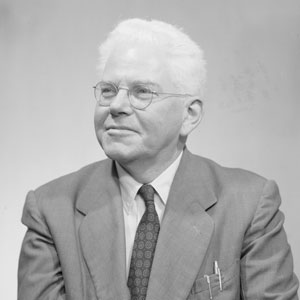
The Academy’s journal, Historical Records of Australian Science, recently published a fascinating article on the role that Academy founder Mark Oliphant played during WWII.
In 1943, Mark Oliphant arrived on the Manhattan Project as a leading member of the British mission. Inside the laboratory he was a measured and skilful physicist, but outside he was a bull that charged headlong into the gates of secrecy and the unholy communion of science, politics and military.
General Leslie Groves, the man in charge of the Manhattan Project, became agitated at the naivety of the self-absorbed scientists and provided an insight on America’s secret post-war intentions of an atomic monopoly. Oliphant, not a man to let explosive knowledge pass him by, headed to the British Embassy in Washington to send a secure report to London that escalated all the way to the top of Britain’s war time leadership. Oliphant was sounding a horn to warn that Britain’s own atomic ambitions and scientific freedoms were under imminent threat.
The journal article by Darren Holden was covered by The Conversation, Late Night Live, Australian Science Channel and Cosmos.
The May paper that received much of the attention was preceded by an article in January that set the scene on Oliphant’s involvement in the American atomic bomb project.
Paul Fraser is the lead author on the third of the journal’s articles by CSIRO scientists describing the history of Australia’s greenhouse gas research. Following two articles on the study of carbon dioxide emissions, Fraser and his colleagues address the issues of non-CO2 gases such as nitrogen oxide and fluorocarbons.
This issue also has an article on research conducted by Professor Ian Rae on the establishment of a radiocarbon dating laboratory in Melbourne’s Museum of Applied Science. Professor Rae also wrote the biographical memoir for chemical physicist Professor Jim Morrison. Other biographical memoirs describe the careers of two other Australian science leaders. Professor Laurie Nichol was a biochemist and twice a university vice-chancellor, while Professor Brian Kay was an expert on mosquitoes and their impact on public health because of the viruses they carry.
There is an interesting selection of book reviews, while the Bibliography of Australian Science for 2017 is also published.
Who can possibly wait six months for the next issue of Historical Records of Australian Science to arrive? Not us! That’s why CSIRO Publishing is now publishing articles ‘online early’—where the peer-reviewed and edited version of record is published online before inclusion in an issue. This is an important adjunct to formal publication in a journal that has only two issues a year.
Find out more about Historical Records of Australian Science, including how you can receive an email alert when an issue is published. Fellows can access the articles for free via a link on the Fellows Only section of the Academy website (requires log-in). All memoirs are published on the Academy website after publication in the journal.
© 2026 Australian Academy of Science